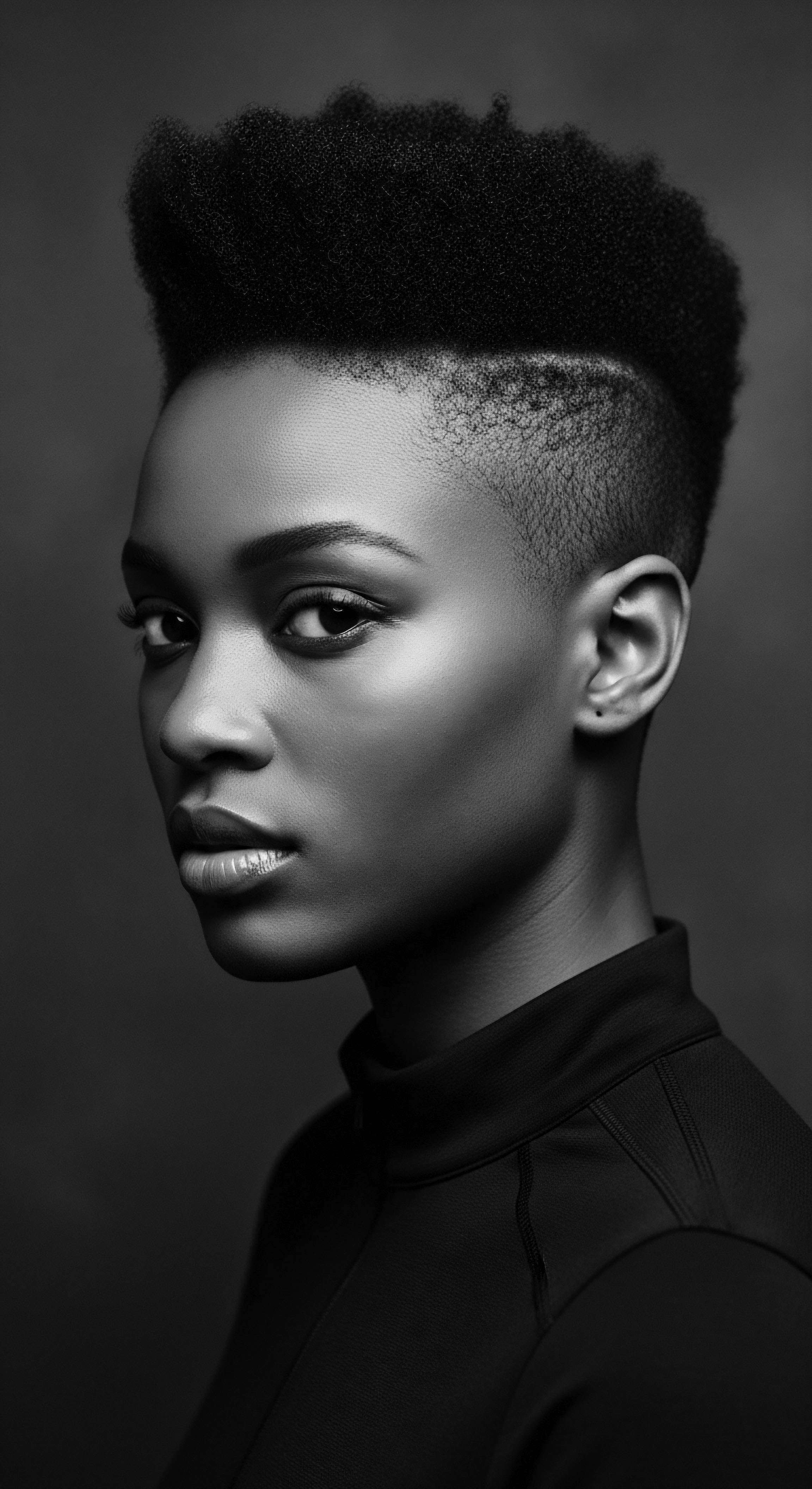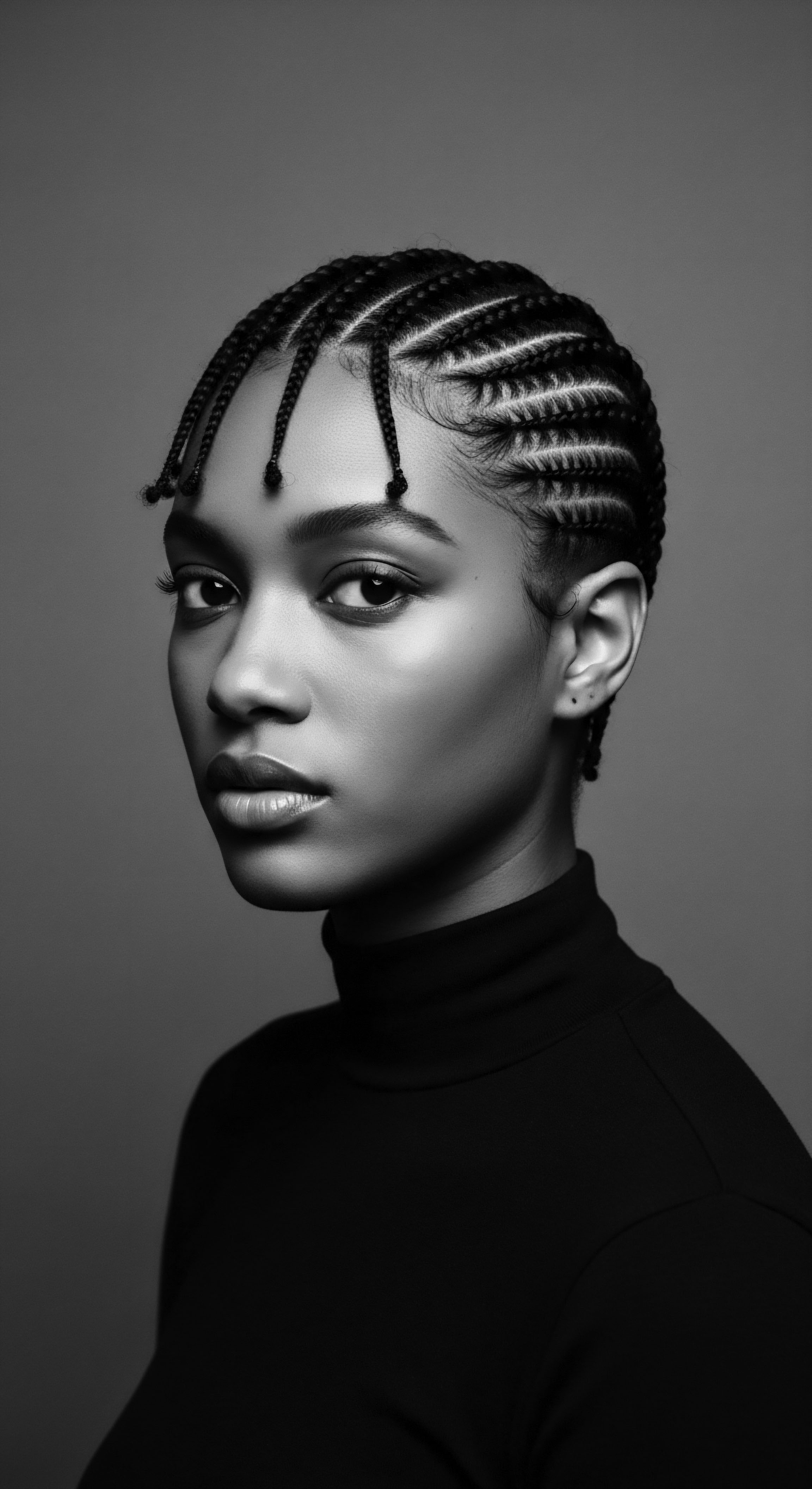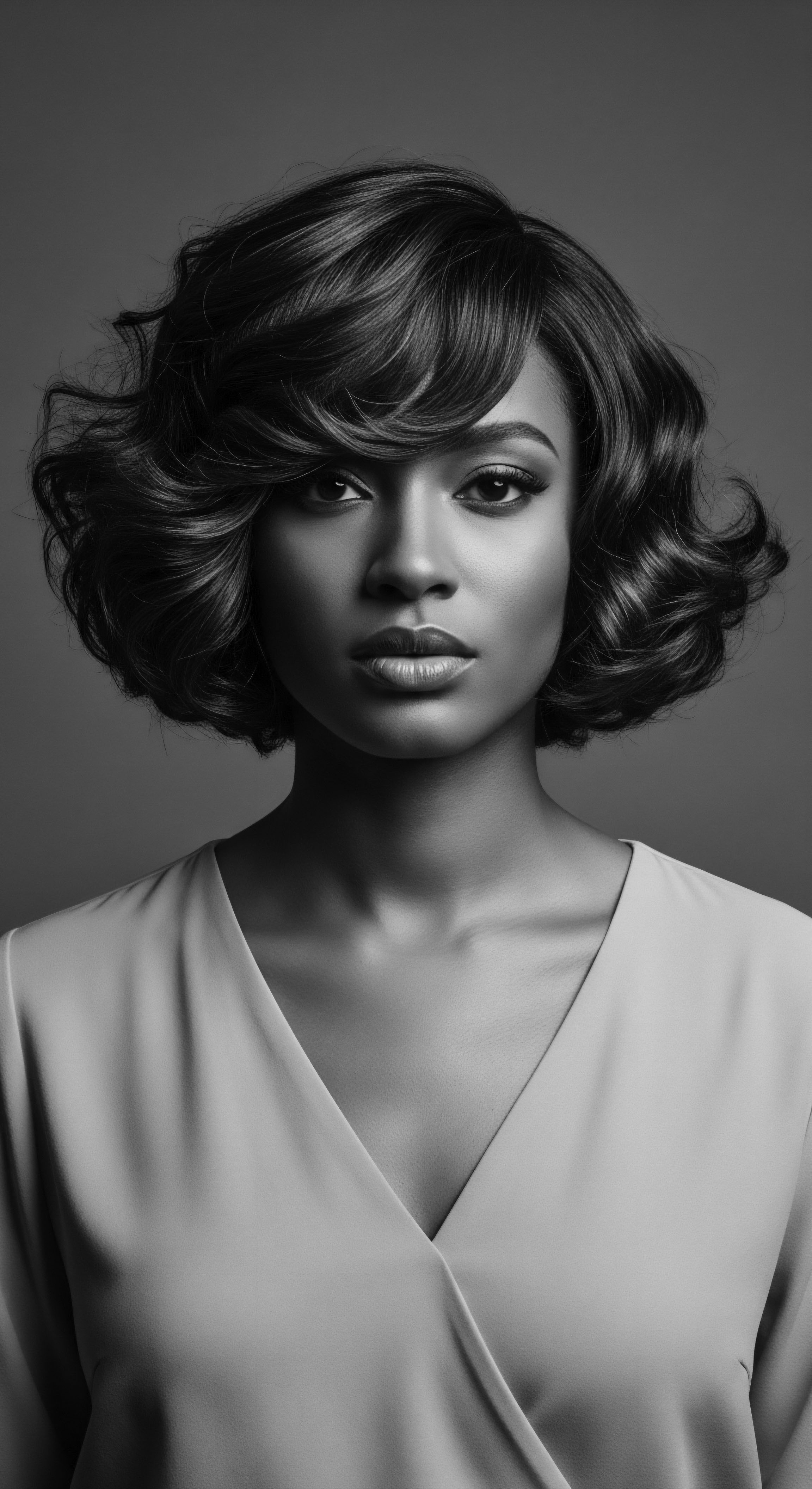
Roots
The coil, the curl, the resilient wave – textured hair holds within its very structure echoes of ancestral wisdom, a living archive of identity and fortitude. For those of us with hair that tells stories in its spirals and kinks, the care rituals we observe today are rarely entirely new. Rather, they are often a beautiful continuation, a contemporary alignment with ancient practices passed down through generations.
This exploration begins at the very source, tracing the indelible connections between our modern routines and the profound heritage of textured hair. It invites us to consider how deeply intertwined our current understanding of hair health truly is with the enduring knowledge of our forebears.

Hair Anatomy From an Ancestral Lens
The unique helical shape of textured hair strands, often exhibiting an elliptical cross-section, contributes to its magnificent volume and distinctive curl patterns. This inherent structure means textured hair can be more prone to dryness and breakage due to fewer cuticle layers and the difficulty natural oils face in traveling down the coiled shaft. Ancestral communities, long before modern microscopy, understood this delicate nature through observation and experience. Their care methods consistently prioritized moisture and protection, recognizing the hair’s need for replenishment and safeguarding.
Consider the traditional practices of various African groups who regularly applied butters and oils derived from their environment—like shea or palm oil—to their hair and scalp. This was not merely about aesthetic adornment; it was a deeply functional approach, intuitively addressing the hair’s intrinsic needs for lubrication and a barrier against harsh climates.
Contemporary textured hair care methods frequently echo ancient wisdom, prioritizing moisture, protective styling, and natural ingredients.

Traditional Hair Classification Systems
Before the numerical and alphabetical systems of today, traditional societies possessed nuanced ways of classifying hair, rooted in observable textures, patterns, and cultural significance. These systems, though unwritten in a scientific journal, held immense value within communities. They often dictated hairstyles, social roles, and rites of passage. For instance, among many West African groups, hair texture was part of a broader cultural vocabulary, influencing identity markers from infancy to elderhood.
The ways communities referred to different hair patterns reflected an inherent understanding of variability, focusing on how hair behaved and what it signified. Modern classifications, while aiming for scientific precision, can sometimes overlook this holistic, culturally embedded context.

Ancestral Lexicon of Textured Hair
Every strand, every coil, every pattern has a name, a story, a place in the vast language of textured hair. The traditional lexicon of textured hair care spoke volumes about communal values, beauty standards, and practical application. Words for specific curl patterns, hair states (like dry or strong), and even tools were deeply embedded in the daily life of various communities.
For example, terms for different braiding techniques or the appearance of well-nourished hair were part of an oral tradition, ensuring knowledge passed seamlessly across generations. These ancestral terms reveal a deep, respectful interaction with hair, where its care was a specialized skill, often belonging to specific individuals or passed from elder to youth.
| Historical Care Aspect Moisture Retention ❉ Use of natural plant butters and oils like shea butter, palm kernel oil. |
| Contemporary Alignment Modern deep conditioners, leave-in creams, and hair oils designed for moisture retention in coiled patterns. |
| Historical Care Aspect Scalp Health ❉ Herbal rinses, massaging with oils, use of natural clays for cleansing. |
| Contemporary Alignment Scalp treatments, pre-poo routines, gentle sulfate-free cleansers, and scalp massages to stimulate circulation. |
| Historical Care Aspect Protection from Elements ❉ Covering hair, protective styles like braids and twists. |
| Contemporary Alignment Wig usage, wide-brimmed hats, satin/silk bonnets and scarves, continuation of protective styles. |
| Historical Care Aspect Hair Strength ❉ Protein-rich plant ingredients, minimal manipulation. |
| Contemporary Alignment Protein treatments, bond-building conditioners, low-manipulation styling methods. |
| Historical Care Aspect The enduring quest for healthy, vibrant hair finds common ground across centuries, linking ancient wisdom to present-day practice. |

Growth Cycles and Environmental Factors Across Generations
The rhythm of hair growth, its cycles of activity and rest, was something ancient communities observed closely, even without the scientific terms we use today. They understood that external factors—climate, diet, and daily practices—held sway over hair vitality. In many African regions, where arid conditions or intense sun were common, hair care protocols adapted to these realities. Diets rich in local, nutrient-dense foods supported overall health, including hair health, from the inside out.
External applications served as environmental shields. This holistic viewpoint, where hair health reflected broader well-being and adaptation to surroundings, is a cornerstone of ancestral wisdom that resonates strongly in contemporary wellness discussions.

Ritual
The shaping of hair has always carried weight, a visible testament to identity, community, and cultural narratives. From the earliest recorded history, textured hair has been an artistic medium, its versatility celebrated through intricate designs and purposeful styling. The methods employed, the tools utilized, and the transformations achieved speak to a heritage of creativity and practical ingenuity. Modern styling approaches, far from being entirely new, often find their genesis in these enduring practices, revealing a deep alignment with the art and science of our past.

Protective Styling Ancestries
The concept of safeguarding textured hair through specific styles is a legacy passed down through countless generations. Long before the term “protective style” entered contemporary discourse, African communities mastered methods to shield hair from manipulation and environmental stress. Styles such as Braids, Twists, and Bantu Knots were not only aesthetically compelling but served vital functional roles ❉ preserving length, retaining moisture, and reducing breakage. These were designs of resilience, allowing hair to rest and flourish.
In ancient times, the patterns of braids could communicate one’s marital status, age, or tribal affiliation. This profound social and spiritual dimension underscores their value.
A powerful instance of this protective practice comes from the Himba Women of Namibia. Their iconic hairstyle involves coating their hair with Otjize, a paste made from ground ochre (a red pigmented stone), animal fat, and aromatic resin. This mixture not only imparts a distinctive reddish hue, symbolizing both blood and earth, but it also provides a crucial protective layer against the harsh desert sun and dry climate. The Himba women’s meticulous application of otjize, a daily or regular ritual passed down through generations, effectively seals in moisture and protects the hair from environmental damage, allowing it to grow to remarkable lengths.
This practice illustrates a direct alignment with modern protective styling principles ❉ minimizing exposure, retaining hydration, and reducing mechanical stress. (McGinty, 2020)

Natural Styling and Definition Echoes
Defining curls, coils, and kinks without harsh chemicals is a pursuit that has deep roots in historical practices. Traditional African communities used various natural ingredients to enhance the inherent beauty of textured hair. Plant-based gels, often derived from mucilaginous plants, provided hold and definition. Oils and butters were applied to impart shine and clump curl patterns, much like modern curl creams and custards.
The understanding that less manipulation and gentle handling preserve the hair’s integrity was ingrained in these traditional methods. Drying methods, often involving air drying or carefully draped hair, avoided the heat that today’s science identifies as a source of damage, thus preserving hair’s inherent moisture and coil definition.
African Black Soap, a traditional cleanser from West Africa, stands as an example of multi-purpose historical hair care. Made from plantain skins, cocoa pods, palm tree leaves, and shea tree bark, its rich composition allowed for gentle cleansing that did not strip the hair of its essential oils. Modern low-lather shampoos and co-washes seek a similar balance, cleaning without depleting the hair’s natural moisture, aligning with the ancient principle of preserving the hair’s natural state.

Extensions and Wigs Through Time
The use of hair extensions and wigs is far from a modern invention. Ancient Egyptians, for example, wore elaborate wigs made from human hair, plant fibers, or wool, adorned with jewels and gold. These were symbols of status, protection from the sun, and sometimes even spiritual significance.
In various African cultures, hair was lengthened with fibers, animal hair, or even plant materials to achieve specific ceremonial styles or to signify social standing. Today’s wide range of wigs, weaves, and braids continues this historical tradition, offering versatility, protection, and opportunities for personal expression, all while paying homage to techniques that predate contemporary fashion.

Tools of Hair Craft
The instruments used in textured hair care have evolved, yet their fundamental purposes persist. Ancient combs, often carved from wood, bone, or ivory, were designed to detangle and sculpt, much like the wide-tooth combs and specialized brushes of today. Tools for braiding, parting, and sectioning have their counterparts in modern-day styling kits.
The use of natural materials for tools reflected a connection to the earth and an understanding of gentle interaction with hair. Contemporary tools, while often synthetic, aim to replicate the efficacy and gentleness of their historical predecessors, particularly those designed to minimize friction and breakage on delicate coils.
- Combs ❉ Hand-carved from wood or bone in ancient African civilizations, used for detangling and creating partings.
- Styling Aids ❉ Plant-based pastes and natural oils for hold, shine, and protective coating, often containing ingredients like shea butter or baobab oil.
- Decorative Elements ❉ Cowrie shells, beads, and precious metals for adornment, indicating status and tribal affiliation.
The artistry of textured hair styling is a continuous dialogue between ancestral ingenuity and modern adaptation.

Relay
The enduring vitality of textured hair is not merely a matter of sporadic attention; it relies upon a continuous, thoughtful regimen. Contemporary routines, meticulously crafted by individuals seeking optimal health for their coils and kinks, often mirror the deep-seated wisdom of ancestral practices. This alignment extends to the profound care given to hair during rest, the selection of nourishing ingredients, and the inventive approaches to challenges. The modern pursuit of radiant hair is a direct continuation of a heritage-rich commitment to holistic well-being.

Crafting Personalized Regimens
The idea of a personalized hair care regimen, tailored to individual needs, is deeply rooted in ancestral wisdom. Traditional communities understood that variations in hair texture, environmental conditions, and lifestyle necessitated adaptable approaches. Remedies were often concocted from locally sourced botanicals, mixed and applied according to specific hair types or conditions observed within the community.
This hands-on, intuitive understanding, passed down through oral tradition and demonstration, predates mass-produced, one-size-fits-all products. Today, the emphasis on understanding one’s own hair type and porosity, then selecting products accordingly, aligns with this ancient, bespoke approach to hair care.

Nighttime Sanctuary and Bonnet Lore
The practice of covering hair at night for preservation and protection is a testament to timeless wisdom. Long before the satin bonnet became a common item in contemporary hair care, African and diasporic communities used wraps and coverings made from natural fabrics to shield their intricate hairstyles and delicate strands while sleeping. These coverings helped to retain moisture, prevent tangling, and maintain style, thereby minimizing daily manipulation.
This simple yet profound act demonstrates a practical application of foresight, reducing friction and preserving the hair’s hydration. The modern bonnet, scarf, or durag, often crafted from silk or satin, directly echoes this historical necessity and practical ingenuity, offering a direct link to ancestral practices aimed at preserving hair integrity.
The Chebe Powder ritual, practiced by the Basara Arab women of Chad, offers a compelling illustration of consistent, protective care. This powder, a blend of various natural ingredients like Croton zambesicus, Mahllaba Soubiane, and cloves, is traditionally mixed with oils or butters and applied to damp hair. The hair is then braided and left coated for days, preventing breakage and sealing in moisture, allowing the women to achieve remarkable hair lengths, often reaching their waists. This practice, handed down through generations, highlights a dedication to preventing moisture loss and mechanical damage.
It is a rigorous regimen, not unlike contemporary deep conditioning treatments and low-manipulation styles that prioritize length retention through consistent, intentional care. This traditional method demonstrates how consistent application of natural compounds can contribute significantly to hair health and length. (Sevich, 2024)

Ingredient Wisdom
A return to natural ingredients marks a prominent feature of contemporary textured hair care. This movement finds a direct mirror in ancestral practices, where ingredients were harvested directly from the earth.
- Shea Butter ❉ Extracted from the nuts of the shea tree, shea butter has been a staple across West Africa for centuries, prized for its moisturizing and protective qualities for both skin and hair.
- Baobab Oil ❉ Derived from the seeds of the “Tree of Life,” baobab oil, rich in fatty acids and vitamins, has been used in African traditions for its nourishing and restorative properties.
- African Black Soap ❉ A multi-purpose cleanser, its ingredients like plantain peels and cocoa pods offer gentle cleansing without stripping natural oils, a precursor to today’s sulfate-free formulations.
- Clays ❉ Rhassoul clay, for instance, from the Atlas Mountains, has been traditionally used for its cleansing and conditioning benefits, removing impurities while providing minerals.
These ancient ingredients, revered for their effectiveness, are now sought after globally, bridging the gap between historical botanical knowledge and modern cosmetic science. The rediscovery of their efficacy validates the profound ancestral understanding of natural remedies for hair well-being.

Addressing Hair Challenges
Addressing common hair concerns like dryness, breakage, and scalp irritation has always been a part of textured hair care. Ancient remedies often focused on soothing the scalp with herbal infusions, strengthening strands with protein-rich plant extracts, and preventing damage through protective measures. The goal was always to cultivate healthy hair from the roots. Modern problem-solving approaches, while benefiting from advanced scientific understanding and new technologies, often arrive at similar solutions.
From bond-building treatments that mimic the strengthening effects of certain plant proteins to anti-itch scalp serums derived from traditional soothing herbs, the alignment with historical wisdom is clear. The underlying principle remains ❉ healthy hair originates from a healthy scalp and well-nourished strands.
| Historical Problem Dryness and Brittleness |
| Traditional Solution Regular application of plant oils and butters (e.g. shea, argan, coconut). |
| Contemporary Parallel Deep conditioning treatments, leave-in conditioners, moisturizing oils. |
| Historical Problem Breakage and Weakness |
| Traditional Solution Protective styles, minimal manipulation, protein-rich plant extracts. |
| Contemporary Parallel Low-manipulation styles, bond-repairing treatments, protein masks. |
| Historical Problem Scalp Irritation/Dandruff |
| Traditional Solution Herbal rinses (e.g. rooibos tea, specific leaves), clay masks. |
| Contemporary Parallel Scalp scrubs, anti-dandruff shampoos with natural ingredients, soothing serums. |
| Historical Problem Length Retention |
| Traditional Solution Consistent protective styling, traditional "coating" methods (e.g. Chebe). |
| Contemporary Parallel Protective styling, regimen consistency, moisture-sealing methods. |
| Historical Problem The ingenuity of past generations in maintaining hair vitality continues to shape present-day care strategies. |

Reflection
The journey through textured hair care reveals a profound truth ❉ our present-day methods are not simply products of contemporary innovation. They are, in fact, echoes from ancient wellsprings, living continuations of ancestral wisdom. The diligent application of nourishing oils, the careful creation of protective styles, the reverence for natural ingredients, and the communal aspect of hair rituals all speak to a heritage that pulses with vitality. This connection assures us that the quest for healthy, radiant hair is a timeless one, deeply tied to identity and cultural legacy.
The coils and kinks we celebrate today carry the stories of generations, a testament to the enduring human spirit that finds beauty and resilience in every strand. To understand this alignment is to honor our past, grounding our contemporary choices in a rich, meaningful history. It invites us to interact with our hair not just as biology, but as a living archive, a continuous conversation between heritage and the present moment.

References
- Casella, S. M. (2021). The Ash Tree as “unwobbling pivot.” Cultural Studies Journal, 10(4), 43-51.
- McGinty, B. (2020). Himba Hair Rituals. INFRINGE Magazine .
- Sevich. (2024). The Cultural Background and History of Chebe Powder. Sevich Official Blog .
- Sherrow, V. (2023). Encyclopedia of Hair ❉ A Cultural History. Greenwood Press.
- Komane, B. et al. (2017). Phytochemistry and Ethnomedicine of the Baobab Tree. Nova Science Publishers.
- Donkor, A. et al. (2014). Antioxidant Properties of Baobab (Adansonia digitata L.) Seed Oil. Journal of Food Science and Technology, 51(8), 1640-1647.
- McMullen, A. (2023). Indigenous Cosmetics and Cultural Preservation. University of Ghana Press.
